Latin America Proximity Access Control Market Size
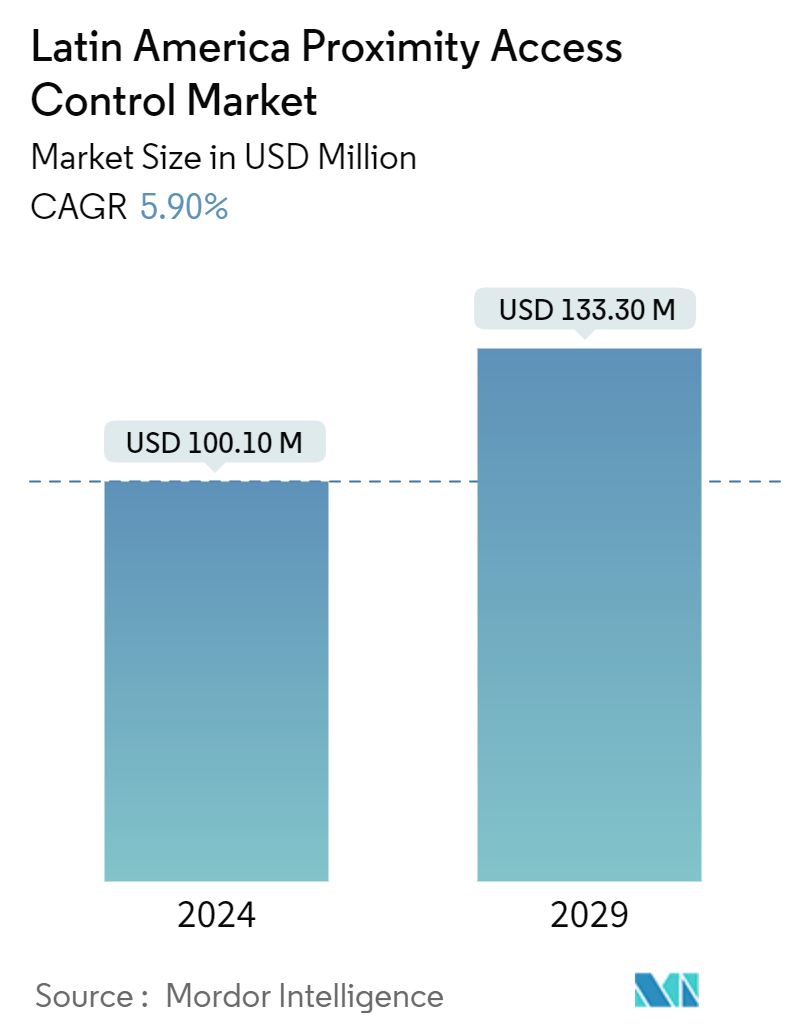
| Study Period | 2019 - 2029 |
| Base Year For Estimation | 2023 |
| Market Size (2024) | USD 100.10 Million |
| Market Size (2029) | USD 133.30 Million |
| CAGR (2024 - 2029) | 5.90 % |
| Market Concentration | Low |
Major Players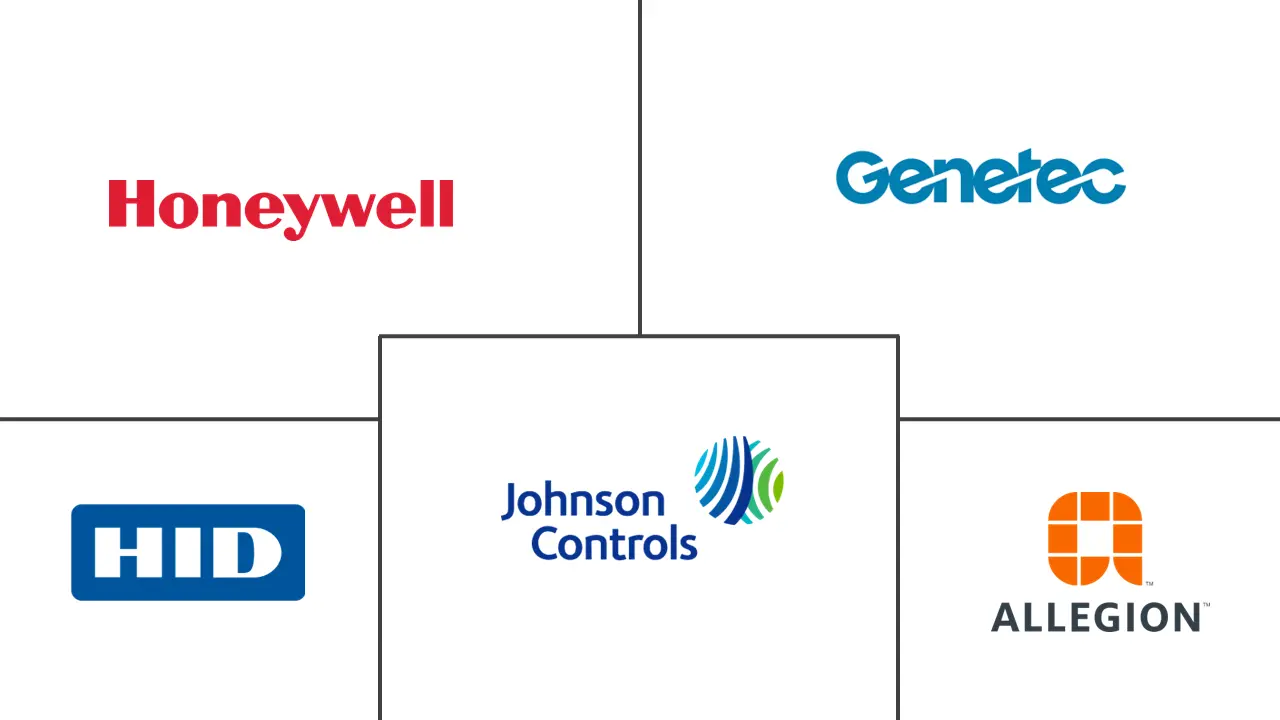
*Disclaimer: Major Players sorted in no particular order |
Latin America Proximity Access Control Market Analysis
The Latin America Proximity Access Control Market size is estimated at USD 100.10 million in 2024, and is expected to reach USD 133.30 million by 2029, growing at a CAGR of 5.90% during the forecast period (2024-2029).
- Proximity access control systems are a fundamental element of security systems used in various industries. These systems enable a unified system to manage and track access to a building, room, or facility area. Prospects for the proximity access control industry are optimistic due to the interoperability with other security solutions, as well as other factors contributing to the increasing growth of the sector.
- With the rapid advancement of technology, access control systems are adapting to the ever-evolving requirements of companies and organizations. The proximity access control market is primarily driven by biometric equipment, with fingerprint recognition technology being the most popular and cost-effective solution. The market also benefits from the growing interconnectedness of devices and the associated security risks.
- The most significant trend in proximity access control system technology is the incorporation of IoT (Internet of Things) devices. Proximity-based access control (PBAC) ensures that IoT devices grant data access solely to authorized users in their immediate vicinity. IoT (Internet of Things) devices in modern buildings are on the rise, allowing for automation and interoperability between systems. Businesses can build a more key security ecosystem by connecting proximity access control panels to IoT devices like smart locks and biometric sensors. IoT is an ever-evolving landscape, increasingly drawing the attention of hackers. The frequency of cyber-attacks on IoT devices is on the rise, which creates demand for efficient security solutions such as proximity access control systems.
- For instance, cities in Brazil are utilizing Internet of Things (IoT) applications to improve urban services and enhance the overall quality of life for their citizens. These applications are used for various purposes, such as smart lighting, waste disposal, traffic management, public transport, and environmental monitoring.
- Proximity access controllers offer enhanced security. However, some organizations may hesitate to adopt these systems due to data privacy and system vulnerability concerns. Countries such as Brazil and Mexico have distinct laws and regulations regarding security systems, which may complicate the adoption process. Additionally, the implementation and management of proximity access controllers could be well-developed in the region due to the lack of IT expertise among smaller organizations, resulting in system performance issues and thus hindering the development of the market.
- The ongoing Russia-Ukraine war and economic slowdown significantly impacted the proximity access control market, as consumer spending was reduced due to inflation. This factor resulted in a decrease in the demand for access control solutions, particularly in sectors such as retail, hospitality, and commercial.
Latin America Proximity Access Control Market Trends
The Door Controllers Segment is Expected to Hold a Significant Market Share
- Proximity access control systems have evolved significantly compared to lock and key approaches. As technology advances, key fob-based entry systems are increasingly in demand in commercial and residential settings. For instance, in January 2024, approximately 6,935 business burglaries and 4,282 home burglaries happened in Mexico, according to the Semaforo Delictivo. The increasing prevalence of security risks, such as theft, vandalism, and unauthorized access, is a significant factor in developing door access control systems. These systems offer a heightened level of security by controlling and monitoring access.
- There has been a surge in demand for touchless access control solutions, such as facial recognition and mobile credentials. Smart door locks have seen a rise in demand in recent years due to the increasing number of smartphone users and the advantages they offer, such as a user-friendly interface and ease of use. These multiple factors, in combination with the growing awareness of safe home solutions, the continual advancement of smart devices, the increasing disposable income of customers, and the growth of internet services, have contributed to the rapid expansion of smart door controllers.
- Smart home security devices are becoming increasingly in demand due to the prevalence and implementation of IoT technology and heightened consumer awareness of security and privacy concerns. Smart door controllers utilize electronic authentication techniques such as biometrics, numerical codes, or wireless signals to open the door. Organizations are looking to improve the security of the premises, regardless of the size, from critical infrastructure sites to smaller offices, educational, and other systems. The increasing demand for advanced security solutions is expected to impact door controllers positively.
- The growing construction industry in countries such as Mexico and Brazil and government support for new home constructions are expected to boost the demand for proximity access control systems. For instance, in April 2024, the federal government of Brazil allocated USD 2.28 billion to construct 112,500 homes under the My Home My Life (MCMV) program, focusing on rural areas and municipalities. Such factors are expected to drive the segment's growth in the coming years.
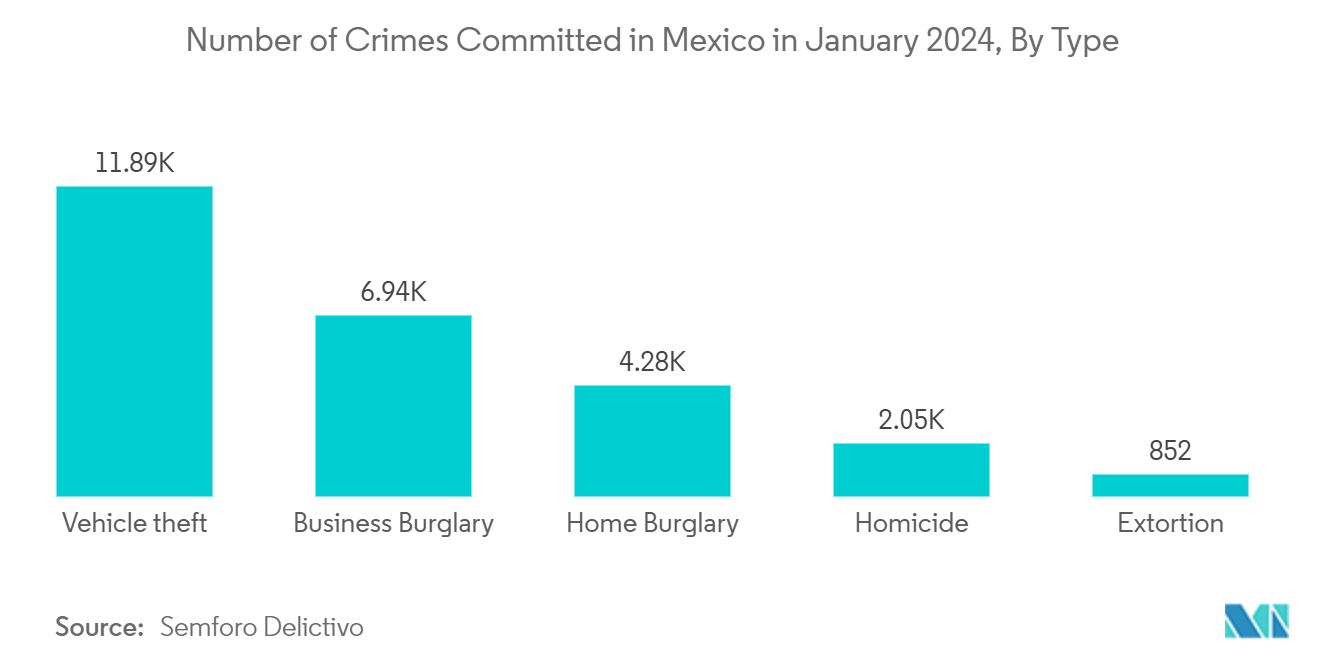
Brazil is Expected to Witness Significant Growth
- The utilization of proximity access controllers, such as biometric scanners, has a wide range of uses, particularly in digital and cyber security. As biometric technology advances, its utilization in Brazil has increased. For instance, facial recognition technology (FRT) is being rolled out in nearly 40 cities across Brazil, with the aim of automating functions in public safety, transportation, and border control. According to a government announcement, biometrics will be used to identify perpetrators of acts of vandalism.
- In September 2023, Palmeiras, a prominent football club, integrated facial recognition technology into its match tickets. This initiative, in collaboration with the Sao Paulo Public Security Secretariat (SSP), has led to the apprehension of 28 criminals over the course of four games at the Allianz Parque stadium, as announced by the government body.
- As the Brazilian financial sector becomes increasingly interconnected and multiple systems become reliant on one another for optimal performance, the risk of security breaches causing extensive harm to data, resources, and reputation is at an all-time high. For instance, in March 2024, FICO, a prominent global analytics software company, released a study titled "Fraud, Identity, and Digital Banking." The study revealed that 5% of Brazilians, equating to 8 million individuals, have fallen prey to identity theft and fraud. This marks a 1.2% increase from the previous survey conducted in 2022.
- As technology advances, proximity access control systems adapt to the ever-evolving requirements of businesses and organizations. Examples of this include integration with cloud-based applications and advanced analytics. The cloud allows access control systems to back up and recover data in the event of a disaster, ensuring that the data is secure and accessible at all times. An increasing number of organizations in Brazil are beginning to recognize that the most effective way to address emerging issues is to utilize the cloud. Moreover, the Brazilian cloud computing industry is undergoing a significant transformation due to enterprises' increasing adoption of multi-cloud solutions, as evidenced by the expansion of Google Cloud partner ecosystems as of August 2023.
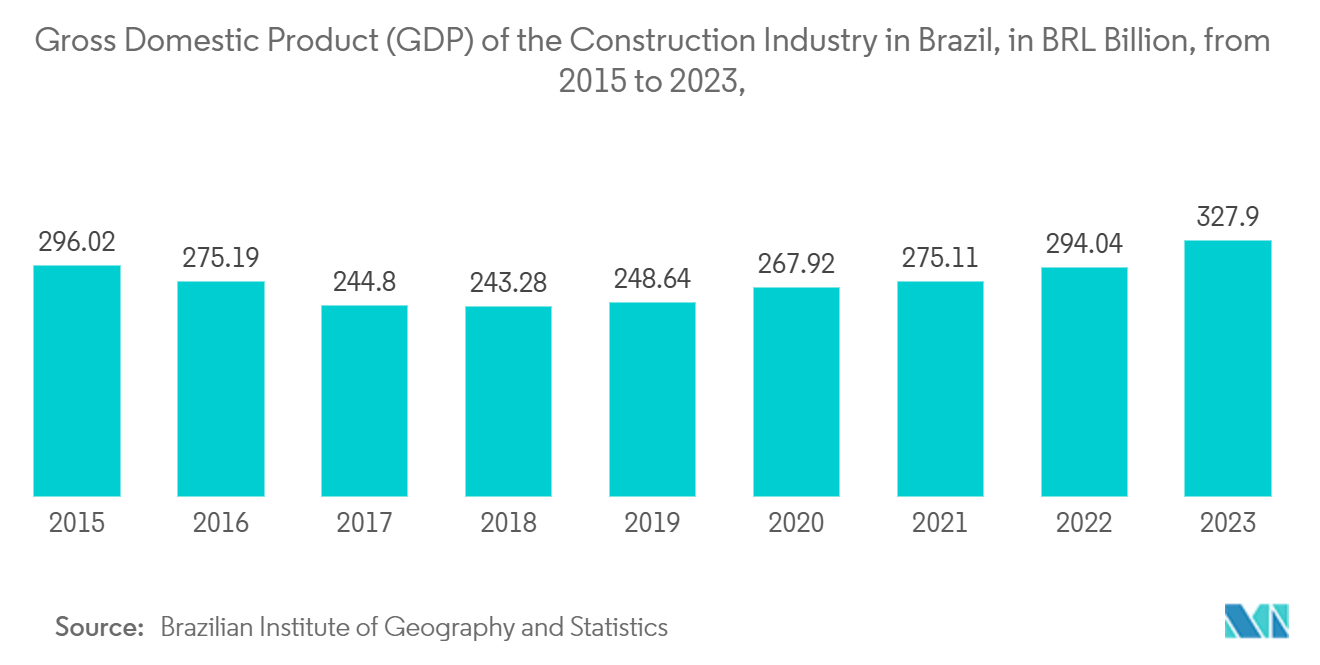
Latin America Proximity Access Control Industry Overview
The Latin American proximity access control market is fragmented. The market is highly competitive and consists of several players. Companies in the market continuously try to increase their market presence by introducing new products, expanding their operations, or entering into strategic mergers and acquisitions, partnerships, and collaborations. Some of the major players are HID Global, Genetec, Honeywell International Inc., Johnson Controls, Verkada Inc., Dahua Technology Co. Ltd, Innovatrics, Schneider Electric, SALTO Systems, ADT, and Vicon.
- April 2024: Johnson Controls introduced Security Lifecycle Management with OpenBlue Services. This innovative offering is tailored to empower customers, bolster building safety, mitigate risks, and optimize the returns on their security technology investments. The solution merges Johnson Controls' OpenBlue suite of interconnected solutions, enabling the monitoring and management of security devices from various vendors. It also includes remote support services, expert insights from engineers, and a streamlined, integrated zero-trust cybersecurity shield.
- January 2024: Integrated Biometrics (IB) announced that its slim Danno FAP 30 biometric capture device is now a part of DataWorks Plus' newest Evolution 3 handheld device. DataWorks Plus specializes in solutions designed for law enforcement, criminal justice, and government agencies. Its offerings include Livescan identity management software and advanced multimodal biometric technology for precise identification and verification.
Latin America Proximity Access Control Market Leaders
-
HID Global
-
Genetec
-
Honeywell International Inc
-
Johnson Controls
-
Allegion Plc
*Disclaimer: Major Players sorted in no particular order
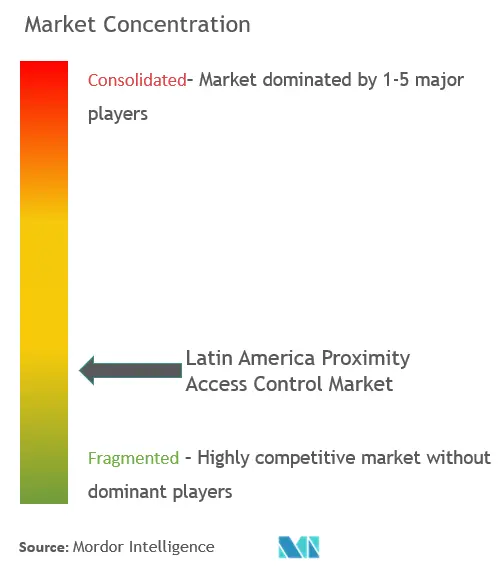
Latin America Proximity Access Control Market News
- March 2024: Allegion PLC launched the Schlage XE360 Series Wireless Locks, a collection of electronic locks designed specifically for the multifamily market. This series marks Schlage's cutting-edge foray into electronic lock technology, with a suite of features tailored to the unique needs of multifamily properties. These locks are engineered for easy integration across a spectrum of common area openings, promising both versatility and convenience for property managers and residents.
- April 2024: HID launched its latest innovation: the OMNIKEY SE Reader Core. This cutting-edge module is crafted to enhance the intelligence of smart access solutions and empower organizations to bolster their authentication and verification practices. The HID OMNIKEY SE Reader Core is revolutionizing physical and logical access with many settings, spanning from connected workspaces and healthcare facilities to educational campuses and office buildings. Notably, it equips integrators with the capability to infuse advanced mobile features into devices, catering to physical and logical access needs.
Latin America Proximity Access Control Market Report - Table of Contents
1. INTRODUCTION
1.1 Study Assumptions and Market Definition
1.2 Scope of the Study
2. RESEARCH METHODOLOGY
3. EXECUTIVE SUMMARY
4. MARKET INSIGHTS
4.1 Market Overview
4.2 Industry Attractiveness - Porter's Five Forces Analysis
4.2.1 Bargaining Power of Suppliers
4.2.2 Bargaining Power of Consumers
4.2.3 Threat of New Entrants
4.2.4 Threat of Substitutes
4.2.5 Intensity of Competitive Rivalry
4.3 Impact of the Aftereffects of the COVID-19 Pandemic and Other Macroeconomic Factors on the Market
5. MARKET DYNAMICS
5.1 Market Drivers
5.1.1 Rapidly Growing Security Concerns and Increasing Crime Rates
5.1.2 The Need for Advanced Authentication Methods and Technology to Safeguard Valuable Items and Confidential Information
5.1.3 Increasing Investments in Smart Infrastructure Projects
5.2 Market Challenges
5.2.1 High Installation Costs
5.2.2 Lack of Integration Challenges with Other Building Systems
6. MARKET SEGMENTATION
6.1 By Solution
6.1.1 Hardware
6.1.2 Software
6.2 By Type
6.2.1 Card Readers
6.2.2 Biometric Scanners
6.2.3 Proximity Readers
6.2.4 Alarms
6.2.5 Metal Detectors
6.2.6 Door Controllers
6.2.7 Wireless Locks
6.3 By End-user Industry
6.3.1 Government Services
6.3.2 Banking and Financial Services
6.3.3 IT and Telecommunications
6.3.4 Transportation and Logistics
6.3.5 Retail
6.3.6 Healthcare
6.3.7 Residential
6.3.8 Other End-user Industries
6.4 By Country***
6.4.1 Brazil
6.4.2 Mexico
7. COMPETITIVE LANDSCAPE
7.1 Company Profiles
7.1.1 HID Global
7.1.2 Genetec
7.1.3 Honeywell International Inc.
7.1.4 Johnson Controls
7.1.5 Verkada Inc.
7.1.6 Dahua Technology Co. Ltd
7.1.7 Innovatrics
7.1.8 Schneider Electric
7.1.9 SALTO Systems
7.1.10 ADT
7.1.11 Vicon
7.1.12 Idemia
7.1.13 Milestone Systems
- *List Not Exhaustive
8. INVESTMENT ANALYSIS
9. FUTURE OF THE MARKET
Latin America Proximity Access Control Industry Segmentation
- Proximity access control is an element of data protection that determines who can access or gain access to company resources, corporate information, and others. Examples of access control systems can be found within security systems, such as locks and fences, biometric systems, motion detectors, and doors.
- The study tracks the revenue acquired through the sale of proximity access control systems by various players in Latin America. The study also tracks key market parameters, underlying growth influencers, and major vendors operating in the industry, which supports the market estimations and growth rates during the forecast period. The study further analyses the overall impact of the aftereffects of the COVID-19 pandemic and other macroeconomic factors on the market. The report’s scope encompasses market sizing and forecasts for various market segments.
- The Latin American proximity access control market is segmented by solution (hardware and software), type (card readers, biometric scanners, proximity readers, alarms, metal detectors, door controllers, and wireless locks), end-user industry (government services, banking and financial services, IT and telecommunications, transportation and logistics, retail, healthcare, residential, and other end-user industries), and country (Brazil, Mexico, and Rest of Latin America). The market sizes and forecasts are provided in terms of value (USD) for all the above segments.
| By Solution | |
| Hardware | |
| Software |
| By Type | |
| Card Readers | |
| Biometric Scanners | |
| Proximity Readers | |
| Alarms | |
| Metal Detectors | |
| Door Controllers | |
| Wireless Locks |
| By End-user Industry | |
| Government Services | |
| Banking and Financial Services | |
| IT and Telecommunications | |
| Transportation and Logistics | |
| Retail | |
| Healthcare | |
| Residential | |
| Other End-user Industries |
| By Country*** | |
| Brazil | |
| Mexico |
Latin America Proximity Access Control Market Research FAQs
How big is the Latin America Proximity Access Control Market?
The Latin America Proximity Access Control Market size is expected to reach USD 100.10 million in 2024 and grow at a CAGR of 5.90% to reach USD 133.30 million by 2029.
What is the current Latin America Proximity Access Control Market size?
In 2024, the Latin America Proximity Access Control Market size is expected to reach USD 100.10 million.
Who are the key players in Latin America Proximity Access Control Market?
HID Global, Genetec, Honeywell International Inc, Johnson Controls and Allegion Plc are the major companies operating in the Latin America Proximity Access Control Market.
What years does this Latin America Proximity Access Control Market cover, and what was the market size in 2023?
In 2023, the Latin America Proximity Access Control Market size was estimated at USD 94.19 million. The report covers the Latin America Proximity Access Control Market historical market size for years: 2019, 2020, 2021, 2022 and 2023. The report also forecasts the Latin America Proximity Access Control Market size for years: 2024, 2025, 2026, 2027, 2028 and 2029.
Latin America Proximity Access Control Industry Report
Statistics for the 2024 Latin America Proximity Access Control market share, size and revenue growth rate, created by Mordor Intelligence™ Industry Reports. Latin America Proximity Access Control analysis includes a market forecast outlook for 2024 to 2029 and historical overview. Get a sample of this industry analysis as a free report PDF download.



